Water Supply
General Information
Introduction
The Nambucca Valley Water Supply System currently serves the towns of Nambucca Heads, Macksville, Bowraville, Scotts Head, Valla Beach and Hyland Park as well as some rural properties along the route of the trunk mains. The number of properties connected to the system is about 6500 serving a population of approximately 15,600.
Water is drawn from an aquifer (in this case a water charged deposit of alluvial gravel), through bores which are located beside the Nambucca River to the north of Bowraville. The gravel beds provide natural filtration of the water and only minimal treatment is required to reach drinking water standards.
Bores
There are currently 10 bores within the borefield supplying water to Council's water system. These are currently set up in 3 banks which are operated as the demand requires. 7 of the bores have a capacity around 30 litres per second while 3 bores have a capacity around 50 litres per second. Each bore is approximately 12 metres deep with a diameter of 250 mm. The aquifer has a small storage capacity estimated to be in the order of 300 mega litres of accessible water and this may vary depending on the flow in the nearby Nambucca River.
Headworks
Council's headworks facility consists of 2 collection tanks 2 pump stations, a valve cluster and infrastructure to store and dose water treatment chemicals. Raw water is pumped from the bores into either or both of the collection tanks. One tank is a rainwater tank holding water that will be pumped to an off river storage via the raw water pump station and transfer mains. The other tank holds water that will be treated and distributed to the town supply system utilising the other pump station.
The raw water is naturally filtered as it flows through the gravel deposits in the aquifer, however it is treated with the addition of chlorine, lime, fluoride and carbon dioxide before it is distributed to consumers. Chlorine is added to disinfect the supply by killing any harmful bacteria. Lime is injected into the supply to adjust the calcium hardness of the water as the natural supply is “soft” and causes corrosion in copper pipelines. Fluoride is added to reduce dental decay, particularly in children in accordance with NSW Health requirements. The Carbon Dioxide gas has been added to readjust the pH of the water back to neutral levels following the addition of the lime.
Once treated the water is pumped to a pair of balance tanks which are located on high ground to the east of Bowraville. From this location and elevation, the water is able to be gravity fed to all reservoirs in the Shire.
Off River Storage
Council has recently constructed an off river storage to secure the shire water supply during times of drought.
The storage is an earth embankment dam with a capacity of 5,000ML. During periods of other than low flow in the Nambucca River water can be extracted by the bores and transfered to the dam utilising the new raw water collection tank and pump station via a 500mm diameter transfer pipeline. Water can be transfered at a rate of up to 300 L/sec.
Water Filling Station at Bowraville
Council has recently installed a water filling station in George Street, Bowraville to provide access to potable water for rural residents and water carters alike.
The water filling station has been proudly funded by the NSW Government in association with Local Government NSW, through the Increasing Resilience to Climate Change program.
The objectives of the project were to increase the resilience of rural and remote residents by providing access to water in the event of emergencies and / or drought conditions. It has been installed potentially as a pilot project to assess the use and accessibility for those Nambucca Valley residents without access to a reticulated water supply, and for emergency services, and has been installed at a site that is accessible for a wide range of vehicles.
The water filling station has both a 25mm and 80 mm outlet and users are advised that they will need to provide their own hoses to connect to the water outlets. Payment is via credit card following the instructions noted on the station. The cost of the water is $7.00 per kL.

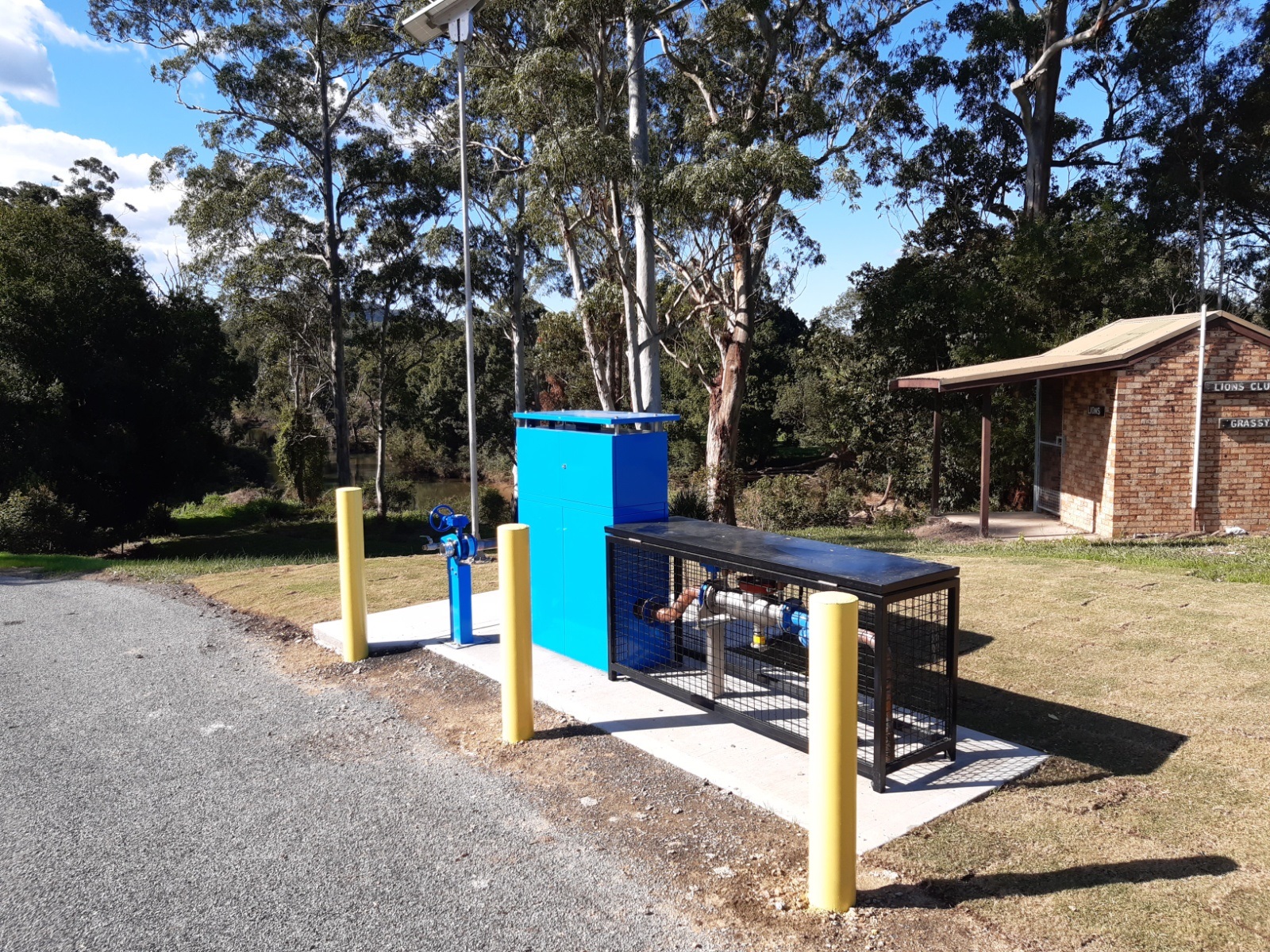
Trunk Main System
The delivery pipe work is known as the trunk main network. The size and length varies as follows:
|
From
|
To
|
Size (mm)
|
Length (km)
|
|
Headworks
|
Balance Tanks
|
450
|
2.8
|
|
Bellingen Rd
|
Bowraville Reservoir
|
150
|
1.8
|
|
Balance Tanks
|
Wirrimbi Junction
|
2 x 450
|
6.1
|
|
Wirrimbi Junction
|
Macksville South Reservoir
|
300
|
7.9
|
|
Macksville South Reservoir
|
Scotts Head
|
200
|
8.3
|
|
Macksville South Reservoir
|
Macksville
|
200
|
1.6
|
|
Wirrimbi Junction
|
Siding Road
|
375
|
3.4
|
|
Siding Road
|
Nambucca Heads
|
375
|
4.9
|
|
Siding Road
|
Kingsworth
|
200
|
1.9
|
|
Nambucca Heads
|
Valla Beach (via Hyland Park)
|
300
|
6.5
|
|
Nambucca Heads
|
Valla Beach
|
150
|
6.7
|
|
TOTAL
|
|
|
51.9
|
The bulk supply to each town is separately metered. Booster pumps in Macksville can be used to increase supply to Scotts Head during periods of peak demand.
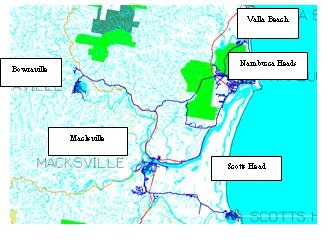
Reservoirs
The role of the reservoirs is to deliver uniform pressure and to provide a reserve of water during periods of high demand or if a break occurs to the pipe network. In most cases the reservoirs hold one (1) day’s peak water demand for its service area.
The number and capacities of the reservoirs are:
| Description |
Number |
Amount |
|
Balance Tanks
|
(2)
|
0.45 and 1.0 megalitres
|
|
Bowraville
|
(1)
|
1.3 megalitres
|
|
Macksville
|
(2)
|
1.3, and 2.9 megalitres
|
|
Macksville South
|
(1)
|
1.8 megalitres
|
|
Scotts Head
|
(1)
|
1.4 megalitres
|
|
Nambucca Heads
|
(3)
|
8.0, 1.1, and 1.3 megalitres
|
|
Valla Beach
|
(1)
|
2.0 megalitres
|
|
Kingsworth
|
(1)
|
0.7 megalitres
|
This provides a total storage of 23.25 megalitres within reservoirs.
Reticulation Mains
The distribution of water from the reservoirs occurs through smaller pipelines known as reticulation mains. The typical size of these mains is from 100mm to 200mm in diameter. They are generally laid in footpaths and roads.
A service connection is then provided from the main to the property. The service pipe is normally made of copper with a diameter of 20 or 25mm. A water meter is installed at the end of the service to register the water usage within the property.
Consumption
The quantity of water used varies greatly over the years, over the time of the year and during the day. A typical household will use just over 400 litres of water each day.
Generally, there has been a downward trend in annual water consumption since the introduction in the early 1990’s of metering and pay for use. Communities are also more water conscious and there is less wasted use of water.
The yearly consumption has varied from a high of 3,250 megalitres in 1991 to current levels of around 1500 kL/annum.
| Year |
Total Megalitres |
| 1990 |
2596 |
| 1991 |
3250 |
| 1992 |
2431 |
| 1993 |
2353 |
| 1994 |
2225 |
| 1995 |
2036 |
| 1996 |
1886 |
| 1997 |
1940 |
| 1998 |
1781 |
| 1999 |
1686 |
| 2000 |
1804 |
| 2001 |
1935 |
| 2002 |
1925 |
| 2003 |
1698 |
| 2004 |
1785 |
| 2005 |
1717 |
| 2006 |
1736 |
| 2007 |
1799 |
| 2008 |
1583 |
| 2009 |
1613 |
| 2010 |
1582 |
| 2011 |
1508 |
| 2012 |
1549 |
| 2013 |
1531 |
| 2014 |
1470 |
| 2015 |
1495 |
Household Information
Detergents
There are many types of detergents available for todays consumer. Selecting the right detergent for your washing machine and situation will not only ensure that you get the best cleaning result but can also assist in doing your bit for the environment.
Many detergents contain high levels of salt and phosphorous which impact adversely on the environment and add significantly to the cost of treating sewage water to a level suitable for discharge to the environment. Phosphorous can lead to excessive growth of blue green algae in inland waterways.
Selecting detergents with low levels of salt and low levels or no phosphorous an help reduce treatment costs and limit our impact on the environment.
CHOICE has carried out a study on laundry detergents and this information is available to you by clicking on the link below:
Water Services
Households are connected to Council’s water main by way of a copper pipe, called a water service. This extends into your property and a shut off valve and water meter are connected near the boundary. Council is responsible for the service up to and including the meter. From the meter into the property it is the owner’s responsibility.
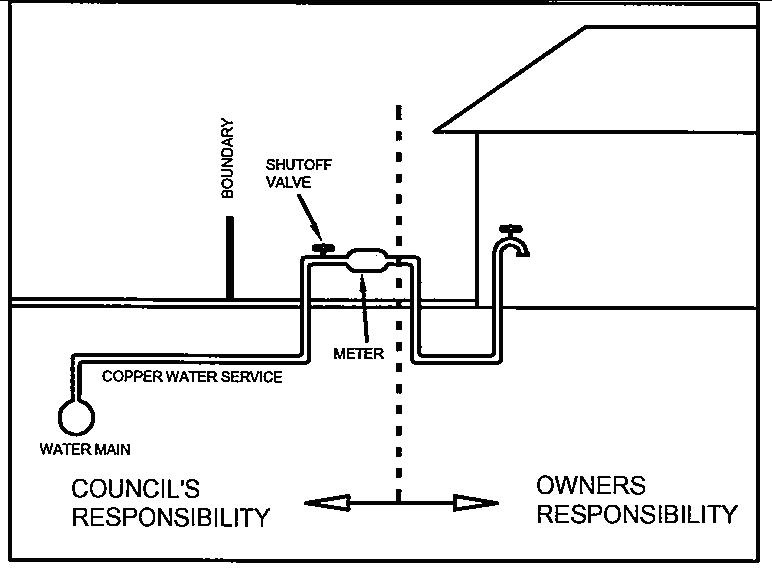
Should a problem occur with Council’s water service or meter, please contact Council on 6568 2555 during working hours. For after hours emergencies please call 1800 26 27 28.
Reading Your Meter
Council has installed various types of water meters since they were first introduced in 1991. Most have four or five dials with black numbers and three or four dials with red numbers. The black numbers are kilolitres (1000 litres), the red numbers in parts of kilolitres. An example is shown below:
The reading is 12,345 kilolitres 678 litres.
Check for Leaks
There are two ways of checking your meter which may help you detect leaks within your water system:
- Observe your meter for a short period when all water consumption devices and taps are off.
If any of the dials revolve, you may have a leak.
- Prior to going to bed, read the meter and record the details. Do not use any water during the night and read the meter again next morning before consuming any water. If the reading has changed, you may have a leak.
If you detect a leak, it is recommended you contact a licensed plumber and arrange repairs.
Water Conservation
In the Home
In the Bathroom
- Save money on your water and energy bill by installing an AAA rated shower rose. Compared to a standard shower that delivers up to 25 litres per minute; an AAA shower rose uses less than 9 litres per minute of water.
- Take shorter showers.
- Toilets are big water users. Use the full flush only when needed.
- Turning the tap off while brushing your teeth or shaving can save 5 litres of water.
- Installing tap aerators and flow regulators on taps that are regularly used for washing hands or brushing teeth is an inexpensive way to use less water.
- Check toilets for hidden leaks by placing a few drops of food colouring in the tank. Wait 15 minutes. If the colour appears in the bowl, you have a leak that needs to be repaired.
In the Kitchen
When peeling or cleaning vegetables, rinse them in a plugged sink.
- Operating a fully loaded dishwasher is more water efficient. AAA-rated dishwashers, when operated fully loaded, use no more water than hand washing and half the amount of water than older models.
In the Laundry
A front loading washing machine is more water and detergent efficient than top loading models
- Match the laundry setting on the washing machine with the amount of laundry to be washed.
- A video demonstrating a few simple ways to make your home more water efficient can be viewed by clicking on the following link:
Outdoors and in the Garden
- Regularly check taps and pipes for leaks.
- Use a broom to clean paths rather than a hose. Ten minutes spent hosing driveways and paths uses around 200 litres of water.
- When washing the car use a bucket and sponge.
- Maintaining lawn areas around 5cm high will reduce evaporation as the blades of grass shade each other. Keep lawn areas to a minimum. Plants with deep roots, like trees and shrubs need less water.
- Aerated soil lets water reach plant roots where it is needed instead of pooling on the surface. A layer of mulch on garden beds will prevent water evaporation by up to 75%.
- Installing a tap timer and drip irrigation system for watering the garden is more water efficient than using a hose or sprinkler.
- Select plants suited to the local environment. Your local nursery will be able to help you with this. Remember natives are water efficient, but many exotics are also low water users.
- Check your pool regularly for leaks.
- Pool covers reduce evaporation and the frequency with which a pool needs to be topped-up.
- Watering plants for longer, less often encourages plants to establish deeper roots. Plants with deeper roots can survive dry spells better.
- Water in the cooler parts of the day, preferably in the mornings when evaporation is less due to lower wind speeds.
- Washing the car on the lawn can prevent detergents from entering our waterways.
In the Workplace
Every person uses about 150 litres per day of potable water in workplace environments. That is about 16 buckets per person per day.
Most of the water used in factories, commercial buildings, education institutions and other workplaces goes in air conditioning, food processing and manufacturing processes. A significant portion used for cleaning, food and drink preparation, gardening, and in toilets and washrooms.
We all have a community responsibility to use water carefully in the workplace by adopting water efficient practices, and ensuring that work processes do not waste water.
The following product library link will provide you with plenty of information to find the right product to save money on water for your home, garden or business.
Rebate Incentive Scheme
Council reimburses some costs for the installation of water saving devices. Details are:-
Eligibility
- Properties must be connected to Town Water Supply (scheme does not apply to rural properties not directly connected to town supply).
- Only applies to replacement of conventional fittings, not new installations or replacement of existing water saving devices.
- Reimbursements of the following will be made:
- Low flow shower head (AAA Standard) $25.00 each (maximum)
- Dual flush toilet cistern $30.00 each (maximum)
- If the cost to install/purchase the device is less than the amounts above, the actual costs will be reimbursed, not the maximum allowed.
- Reimbursements will be made for a maximum of two (2) of each type of device per household.
- Reimbursements will only be made to the owner(s) of the premises.
- Commercial tourist operators (such as caravan parks, holiday units etc) should make formal enquiries prior to replacing these fittings. The Director of Engineering Services will assess each individual claim.
How to make a claim:
The claimant shall complete the application form (available from the Administration Centre at 44 Princess Street, Macksville, the Works Depot 20 Gumma Road (off River Street) Macksville or from Council’s website at www.nambucca.nsw.gov.au.
Please submit the following to the Storeman or Water and Sewerage Supervisor at the Works Depot, 20 Gumma Road (off River Street) Macksville:
- completed application form
- original receipt
- the conventional fitting which has been replaced (these will be disposed of by Council).
Details will be recorded and checked to ensure compliance. If satisfactory, a reimbursement will be approved and payment by cheque will be forwarded to the applicant at the address shown on the application form.
Water Restrictions
Current Restrictions
Current Restriction Level is set to WATER CONSERVATION MEASURES.
Council adopted an amended water supply policy on 26 November 2015. The policy includes a simplified water restriction table that is proposed to be common to all NSW North Coast Councils. Residents are requested to conserve water and the table includes a water conservation measure that is in force at all times.
All water usage and associated activities must not cause pollution as defined under the Protection of the Environment Operations (POEO) Act 1997.
You are advised that Section 637 of the Local Government Act 1993 allows for penalties of up to $2200 for any person who wilfully or negligently wastes or misuses water from a public water supply, or causes such water to be wasted.
Council has designated field officers for the purpose of detecting breaches of the current water restrictions and intends to take legal action against any persons involved in such breaches.
For a first offence - $220 For second and subsequent offences - $2200
GENERAL DOMESTIC

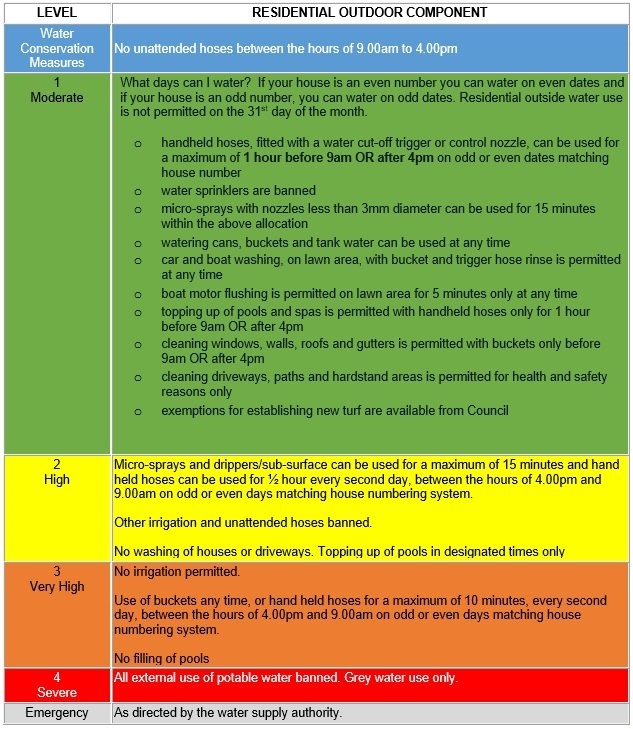
PUBLIC AREAS, COMMERCIAL AND INDUSTRIAL

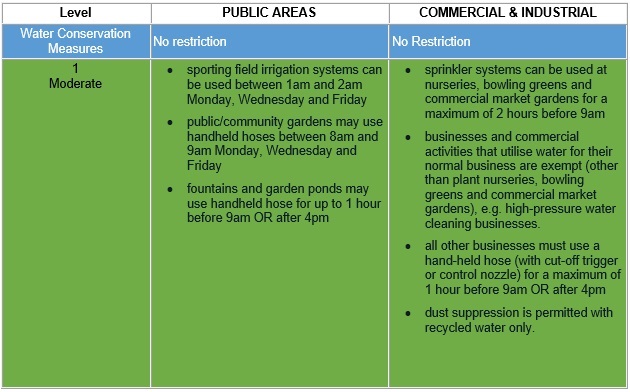
Definitions:
Fixed hoses include sprinklers, sprays, irrigation systems and unattended hoses.
Buckets relate to buckets, watering cans or the like filled directly from a tap not via a hose.
Motor vehicles include cars, utilities, trucks, motor bikes, trailers, caravans & the like.
Boats include all forms of marine craft and also refers to washing and flushing motors.
‘Odds and evens’ relate to the street number matching the day of the month (ie water usage is permitted in properties with an even number on even days of the month, odd numbers on odd days)
* Apply to Council for times
RECENT PROJECTS
Water Supply Strategy/Off-Stream Storage
After the droughts of 1991 and 1992, Council became aware of the need to examine the security of the Water Supply Scheme and completed the 1994 Strategy Report. This study concluded that additional security was needed and that in addition to demand management measures such as user pays pricing, an off-river storage would be the best option to meet the security shortfall and allow for environmental flows in the Nambucca River to be maintained.
Based on the above studies and community feedback, Council implemented a number of demand management measures with success and was also progressing with the implementation activities associated with the off-river storage which was to be located about 2kms north of Bowraville. In 1999 MIDCO scaled down its operation, and as it consumed about 20% of the total annual supply, a review of the impact was undertaken. The results indicated that the existing headworks, based on the existing extraction licence conditions, was adequate to meet average annual demands up to year 2020.
During the extended drought of 2002/2003, increased levels of water restrictions were applied, and the existing regular supply came close to failure prompting Council to activate the drought emergency response strategy. The rains in late January 2003 eased the situation and Council in conjunction with the Department of Energy Utilities and Sustainability (DEUS) commissioned a study to review the security requirements based on information obtained during the drought.
This review was completed by the Department of Commerce and concluded that the Nambucca Water Supply Scheme is highly vulnerable to droughts and additional security was needed as soon as possible (with planning for the additional security commencing immediately).
The objective is to provide Shire residents and businesses with an acceptable level of drought security and to secure the current and future sustainability of the aquatic ecology and the river dependent industry.
Construction of the Off River Storage was completed in October 2014 and the storage is currently being filled.
Integrated Water Cycle Management (IWCM)
IWCM (Integrated Water Cycle Management) is a way for Council to manage its water systems to maximise benefits to the community and environment. It involves the integration of water supply, sewerage and stormwater, so that water is used optimally within a catchment resource, state and national policy context.
IWCM deals effectively with complex linkages between different elements of the urban water cycle, both within the urban area and between the urban area and its water related catchment.
Integrated systems often rely less on natural water sources as more benefit is made of water already being used through demand management, effluent reuse and stormwater use. IWCM also involves improved communication and sharing with other water users and managers. In particular, communication with the local Catchment Management Authority is crucial to achieve integration with planning in the surrounding catchment.
IWCM adopts the following 5 basic principles:
- Consideration of all water sources (including waste-water) in water planning;
- The sustainable and equitable use of all water sources;
- Consideration of all water users;
- Integration of water use and natural water processes; and
- A whole of catchment integration of natural resources use and management.
These 5 principles are used to achieve the following three IWCM objectives:
- Identification of Key Water Cycle Issues;
- Identify the urban context of these issues; and
- Identify and implement strategies that will manage these issues appropriately.
The IWCM Strategy Report has now been completed and can be viewed on Council’s website by clicking on the following link:
Drought Management Plan
During the 2002/2003 drought Council arranged the preparation of a Drought Management Plan. This document outlines:-
- The recent drought performances for future reference including capacity of the system, stream flows, consumption levels and aquifer performance.
- The drought management process including restriction levels, trigger, and actions.
- The emergency response strategy detailing opportunities for supplementing supply in extreme droughts.
The drought management strategy is considered to entail a significant level of risk. Its purpose is to serve as a management tool whilst Council is in the process of taking action to make provision for a secure water supply.
Download the Drought Management Plan Executive Summary.(PDF, 15MB)